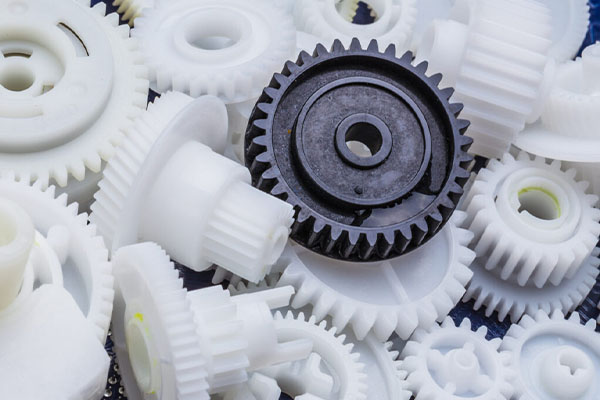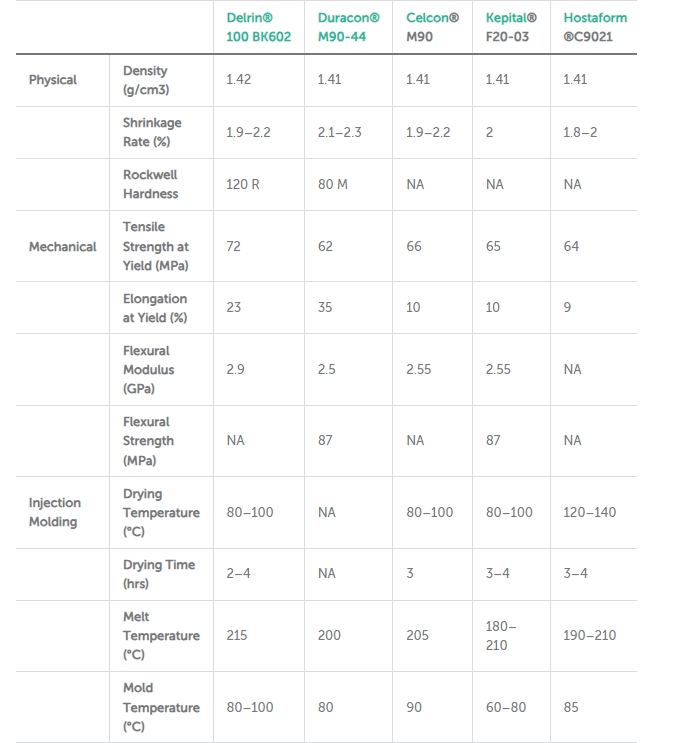POM Processing – POM Injection Molding
Polyoxymethylene (POM) is a high-performance engineering thermoplastic that contains both homopolymer and copolymer forms of acetal. POM processing is used to create parts from POM. Although homopolymer acetal’s highly organized crystalline structure gives it more strength, its exact melt temperature makes processing it challenging. Because copolymer acetal only contains sections of crystallinity, it is mechanically weaker than acetal with a wider processing temperature range.
While copolymer acetals are available from many manufacturers, only DuPont produces the resin utilized in Delrin®, a homopolymer with remarkable qualities. Graded according to resistance, stiffness, viscosity, and strength, Delrin® polymers are suitable for plastic injection molding as well as CNC machining.
Injected molded POM parts find use in fluid management, automotive, medical, and healthcare applications.
This article looks at certain design principles and POM processing factors, as well as the material properties of POM plastics and the benefits of POM injection molding. Additionally, our injection molding design guide contains advice, best practices, and recommendations for dealing with injection-molded POM parts.

Properties of POM Material
Here are the physical, mechanical, and molding properties of various POM processing trade names, with Delrin 100 being the sole homopolymer, while the others are acetal copolymers.
As the data illustrates, POM exhibits exceptional tensile and flexural strength but has a notable shrinkage rate. It’s worth noting that specific POM processing grades can be modified with fillers to enhance mechanical strength, corrosion resistance, or resistance to UV (ultraviolet light).

Advantages of POM Injection Molding
POM is a high-strength engineering thermoplastic with a plethora of valuable attributes:
Fatigue Resistance
POM processing boasts impressive fatigue resistance and is suitable for applications involving multiple load/unload cycles, such as gears. Homopolymer POM (e.g., injection molded Delrin®) outperforms copolymer POM in terms of fatigue strength.
Creep Resistance
Injection-molded POM exhibits strong resistance to creep, which is the tendency of solid materials to undergo gradual deformation when subjected to prolonged mechanical stresses. POM processing can withstand long-term loading with minimal permanent deformation.
High Strength
POM plastics offer excellent mechanical properties, including rigidity, tensile strength, and flexural strength, with homopolymer acetals exhibiting superior mechanical characteristics. High-strength POM processing finds applications in products like conveyor belts and safety restraints.
Low Friction
POM is distinguished by its exceptional lubricity due to its low coefficient of friction, making it ideal for situations involving sliding friction. Injection-molded POM also demonstrates robust wear resistance, resisting the progressive loss of surface volume caused by repeated rubbing.
Food Safe
Injection-molded POM parts can be manufactured from grades that comply with food safety standards established by entities such as the FDA, USDA, NSF, Canada AG, or 3-A Dairy. These applications include plastic parts for food processing equipment.
Dimensional Stability
Despite its relatively high shrinkage rate during injection molding, POM exhibits excellent dimensional stability once parts have cooled, enabling it to maintain its form and adhere to tolerances in demanding applications.
Corrosion Resistance
POM resists the majority of fuels and solvents, making it a common choice for molding fuel tanks and chemical storage containers. However, it is vulnerable to phenols and does not withstand strong acids and bases.
Heat Resistance
Injection-molded POM can endure continuous service temperatures up to 105°C. Homopolymer POM offers superior instantaneous heat resistance, while copolymer POM exhibits better long-term thermal resistance. It’s important to note that POM is flammable and does not self-extinguish once ignited.
POM Injection Molding Design Guidelines
Designing for manufacturing (DFM) and adhering to best practices are essential for part designers working with POM injection molding.
Wall Thickness
It is recommended to maintain a wall thickness between 0.030 and 0.125 inches for injection-molded POM parts. To ensure optimal results, aim to limit thickness variations to within 15% of the nominal wall thickness. Excessively thick walls are discouraged due to high shrinkage rate for POM processing, while very thin walls can pose challenges, potentially leading to underfilling or defects like knit lines.
Tolerances
POM’s propensity for significant shrinking means that thicker wall sections can negatively impact injection molding tolerances.
Radii
POM processing is sensitive to high-stress concentrations, emphasizing the need to maintain radii at a minimum of 25% of the nominal wall thickness. If feasible, 75% of the nominal wall thickness is the optimal choice.
Draft Angle
POM’s excellent lubricity reduces the need for high draft angles to ensure effective part ejection. Typically, 0.5 to 1 degrees of draft suffice for injection-molded POM. Zero draft may also be feasible and necessary, particularly for components like gears and bearings.
No Copper Contact
Avoid any contact between molten POM and copper within the injection molding system, as this interaction leads to a chemical reaction causing POM decomposition.
Mold Material
Opt for stainless steel for POM injection molds, as POM is highly corrosive when in its molten state. Chrome-plated molds tend to deteriorate over time and are thus not recommended for use with POM.
Bonding Considerations
POM processing parts do not readily adhere to each other, so it’s preferable to design assemblies of POM parts to snap together or employ other mechanical fastening methods.
Considerations of POM Processing
Processing POM can be challenging due to its sensitivity to high temperatures. For injection molders, there are four critical considerations:
Heat
To prevent the breakdown of POM into corrosive by-products, keep the temperature of molten POM below 210°C. Use a short heating cycle, where an increase in temperature corresponds to a decrease in the recommended residence time. Maintain mold temperatures between 60 to 100°C for optimal results.
Moisture
Although POM has a low moisture absorption rate of 0.2 to 0.5%, it is often advisable to dry POM resin before processing, typically for 3 to 4 hours, with the drying temperature dependent on the POM grade.
Molding Parameters
Successful injection molding of POM parts requires maintaining a medium to high injection speed and an injection pressure ranging from 70 to 120 MPa.
Shrinkage
Proper modeling is crucial due to POM’s shrinkage rates of 2 to 3.5%. Most of the shrinkage occurs while the part is within the mold during the cooling stage, with some additional shrinkage after ejection, particularly for Delrin®. This homopolymer POM variant exhibits higher shrinkage rates compared to copolymer acetals.
POM Parts Processing at Sungplastic
Although POM processing is difficult, injection molded POM parts have excellent properties such as high lubricity, mechanical strength, and fatigue resistance. We work with Sungplastic to provide design-for-manufacturing (DFM) feedback at every step along with injection molding quotes and manufacturing guidance. No matter how complex your design is, you can rest assured that we have the POM injection molding experience and skills to produce the high-quality parts you need.
Ready to start your next project? Contact us today.
Get a free quote and design analysis today.
We’ll reply to you within 6 working hours.
We respect your privacy.
+86 139 2927 4777 (WhatsApp, Wechat)
